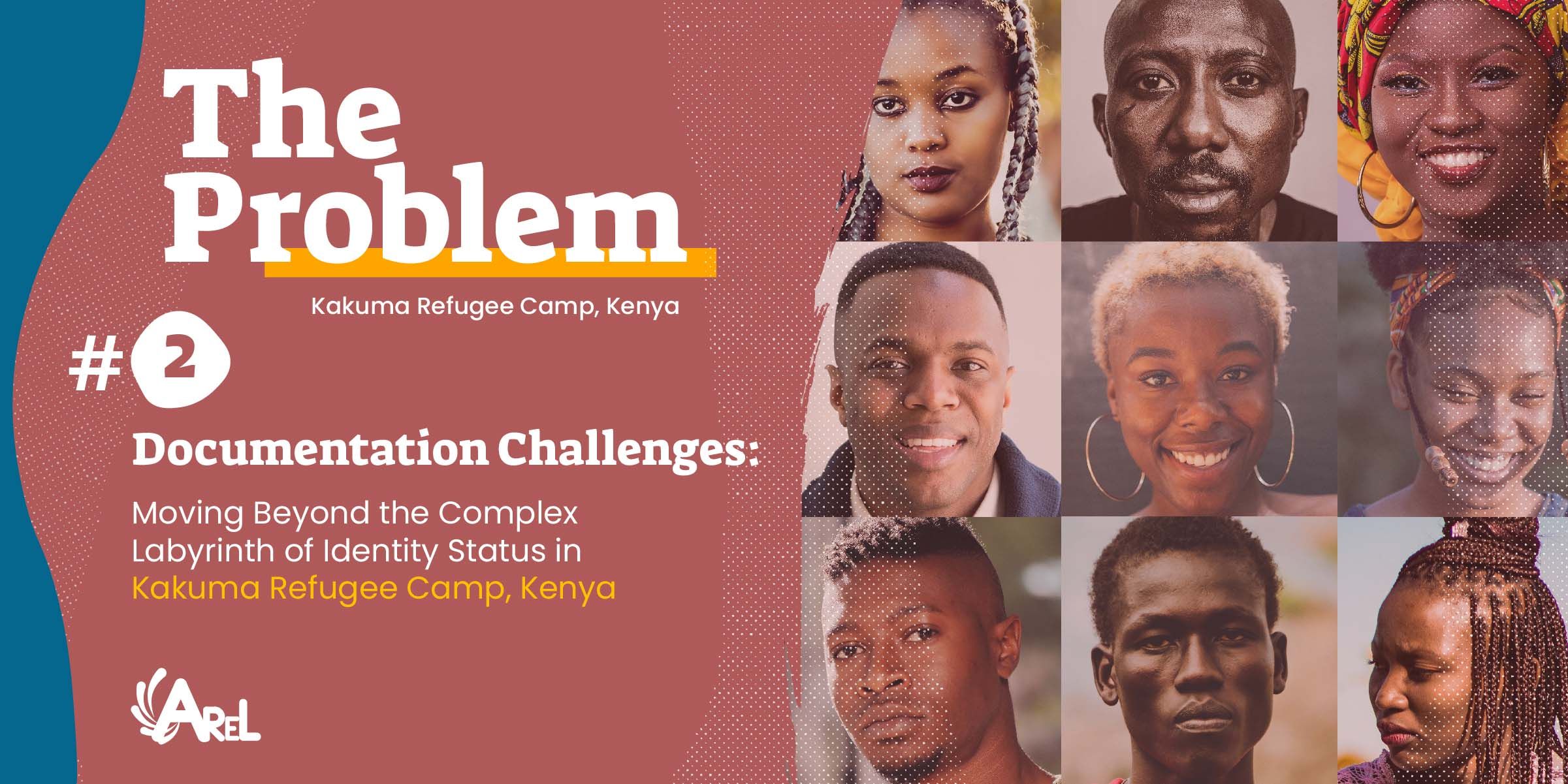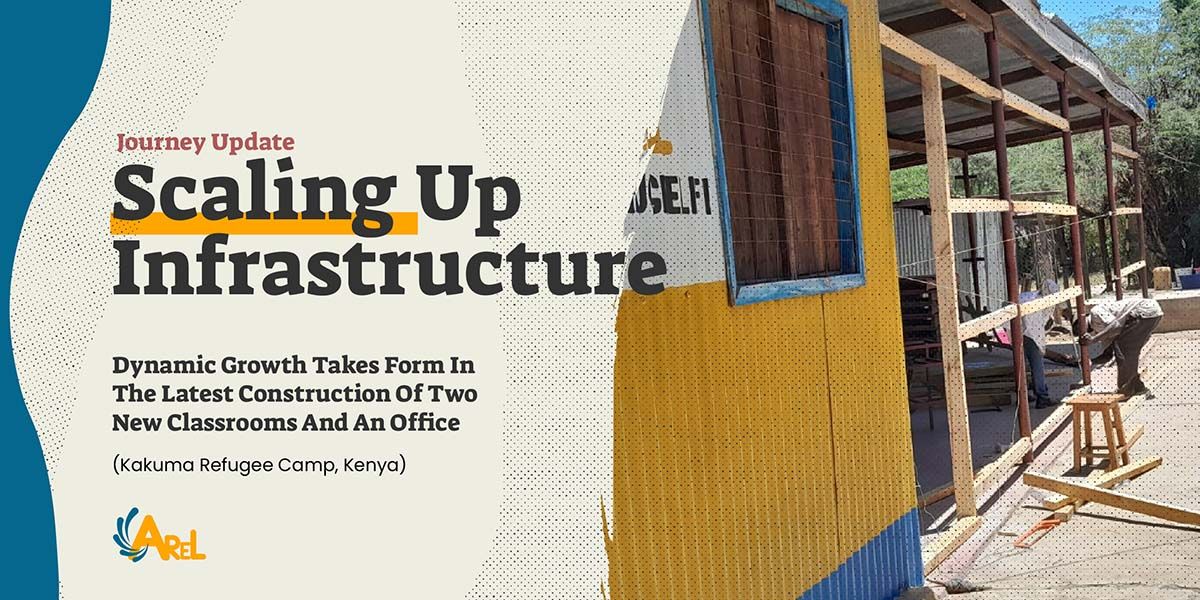
Author
AReL

The Problem - Part Two: Documentation Challenges (Moving Beyond The Complexities of Identity Status in Kenya)
Documentation as a Pillar of Integration
Documentation, the unsung hero of effective refugee integration, is the gateway to fundamental rights, protection, and participation. It allows refugees the chance to build the life they envision. For many refugees, documentation, particularly work permits, is their ticket to livelihood, critical in unlocking opportunities and tapping into their potential. Such documentation promises proper integration, where refugees can work, contribute to the economy, and build a future in their new homeland. The joint efforts of the UNHCR and the Kenyan government through initiatives like the Shirika Plan underline this commitment.
|
Caroline Njuki from the International Labor Organization (ILO) expressed, "If we could expedite, for instance, issuance of movement passes, that would be great." Caroline further explained the importance of work permits, stating, "Refugees at times have opportunities open to them, but they can't take them up because there are work permit delays. And why does the work permit delay? Because they do not have a refugee ID. Why don't they have a refugee ID? Because there is backlog in refugee status." |
Backdrop: A Tapestry of Historical Challenges - Emerging from a Legacy of Complexities
Kenya's experience with refugee and immigration matters is deeply embedded in its history and geographical position. Since its independence in 1963, the nation has seen waves of refugees, mainly from neighboring countries plagued by civil unrest, political turmoil, and other crises.
In the 1990s, the Great Lakes refugee crisis saw hundreds of thousands, mainly from Rwanda and Burundi, seeking asylum in Kenya. Similarly, over the years, conflicts in South Sudan, Somalia, Ethiopia, Burundi, the Democratic Republic of Congo, Eritrea, Uganda, and Rwanda have pushed many to cross borders into Kenyan territory.
Each wave, however, hasn't merely been about providing shelter but managing identities, ensuring these individuals have a place in society, and, most importantly, allowing them to earn a livelihood. Historical challenges related to documentation, magnified by the sheer number of refugees and evolving global scenarios, have presented a monumental task. Yet, with the Global Compact on Refugees framework and Kenya's approach exemplified through the Shirika Plan, the narrative is shifting towards socio-economic inclusion, not just of the refugees but in symbiosis with the local Kenyan communities.
Breakdown of the Problem:
As we delve deeper into the intricacies of documentation challenges faced by refugees in Kenya, it becomes evident that these challenges are multifaceted and interconnected. From the initial stages of seeking refugee status to the complexities of maintaining valid documents, the spectrum of issues is vast. Each problem not only represents a formidable hurdle but also underscores the profound impact on refugees' daily lives and aspirations. Let's unpack these challenges individually to understand the landscape comprehensively.
1. Complexity of Acquiring Documentation:
Beyond mere paperwork, the process of acquiring documentation is a daunting gauntlet of intricate steps. These complexities hinder administrative procedures and fundamentally impact a refugee's ability to engage economically, restrict their movement, and deter their social inclusion in the host community.
2. Lack of Legal Documentation:
The absence of legal IDs translates to an invisible existence. This invisibility means refugees often can't access essential services like healthcare, education, or even basic societal participation, creating a ripple effect of isolation and vulnerability.
3. Difficulty in Obtaining Refugee Status:
Beyond the tedious paperwork, refugees grapple with protracted waiting times and a maze of procedural requirements. This extended ambiguity keeps them in limbo, creating a barrier to assimilation, accessing services, and prolonging their uncertainty.
4. Security Concerns:
In refugee camps or urban areas, the threat of theft or document damage adds another layer of anxiety. Losing these crucial documents can push them further into administrative oblivion, making it even harder to re-establish their identity or claim rights.
5. Limited Access to Records:
With prior educational or professional records, refugee children can avoid obstacles in school enrollment, while adults find it challenging to secure jobs that match their skills, resulting in underemployment or unemployment.
6. Restricted Mobility:
With limitations on movement, even basic tasks like visiting government offices become monumental challenges. This restriction amplifies their isolation and can deter them from seeking necessary services.
7. Language Barriers:
Miscommunications arising from language differences can stall administrative processes, making it even more challenging to understand, apply for, or obtain vital documents.
8. Risk of Statelessness:
The dire state of having no recognized citizenship anywhere exacerbates documentation issues. Statelessness multiplies the challenges refugees face, leaving them in constant liminality.
9. Legal Status & Proof:
The absence of documentation leaves refugees in a precarious position. It exposes them to risks like deportation, detention, or exploitation without legal safeguards.
10. Digital Documentation Concerns:
While digital IDs offer a glimmer of hope, they bring their own set of challenges, from data breaches to the misuse of personal information, adding another layer to the complex issue of documentation.
11. Backlogs:
Overburdened Systems and delayed processing exacerbate the challenges an already fragile population faces. Delays in obtaining the necessary documentation further push refugees to society's margins, excluding their participation and aspiration for prosperity and self-reliance. Given its cascading ripple effects, it is worth further breaking down the backlog issue.
The Backlog Issue:
1. Overburdened Systems:
Host countries, especially those with limited infrastructure, can be overwhelmed by sudden, large influxes. This misalignment between demand and capacity results in overburdened systems, further delaying processes.
2. Delayed Processing:
Overburdened systems mean long waits for refugees. This keeps them in a state of prolonged uncertainty and has more profound psychological impacts, heightening feelings of alienation and distress.
3. Implications for Integration:
Delays due to backlogs hinder the smooth integration of refugees. Extended wait times can stifle their motivation and ability to seek services, find jobs, or enroll in education.
4. Security Concerns:
When backlogs extend, it becomes harder to perform adequate background checks, leading to potential security vulnerabilities within host communities.
5. Resource Allocation Issues:
Prolonged backlogs can misdirect resources. Temporary solutions might become long-term, stretching resources thin and deteriorating the quality of services offered to refugees.
6. Administrative Strain:
The constant pressure, combined with the emotional toll, can burn out administrative staff, leading to inefficiencies.
Looking Forward:
The winds of change are blowing in Kenya, ushered in by the collaborative efforts of the Kenyan government and international bodies such as UNHCR, ILO, and IRC. The high-level dialogue on transitioning refugee camps under the Shirika Plan is a monumental stride toward this future. This plan promises more than just refugee management; it's about socio-economic inclusion, transforming refugee camps into integrated settlements where refugees and local communities can thrive.
The Refugees Act of 2021 reflects the Kenyan government's commitment, which acknowledges the contribution of refugees and provides them with the necessary documentation to access services and job opportunities. This act, combined with the evolving Shirika Plan, is set to redefine how refugees integrate into Kenyan society, promising them safety and a chance at a dignified life.
Moreover, as we transition to a digital era, the move towards unique personal identifiers such as the "Maisha Numbers" signifies Kenya's commitment to streamline processes, ensuring that every individual has a rightful place in society regardless of status.
With the Kenyan government, UNHCR, and various stakeholders at the helm of this transformative journey, refugees' challenges, particularly around documentation, a brighter, inclusive future awaits, where every refugee is empowered, their aspirations are acknowledged, and their potential is unlocked.
The intertwined documentation challenges for refugees are an intricate dance of history, progress, and personal struggles. But the path ahead holds promise. By drawing on collaborative global efforts and embracing technological advancements, there's a palpable hope for a world where every refugee can be seen, heard, and dignified in their new homeland.
Article Tags
The Problem - Part Two: Documentation Challenges (Moving Beyond The Complexities of Identity Status in Kenya)
Documentation as a Pillar of Integration
Documentation, the unsung hero of effective refugee integration, is the gateway to fundamental rights, protection, and participation. It allows refugees the chance to build the life they envision. For many refugees, documentation, particularly work permits, is their ticket to livelihood, critical in unlocking opportunities and tapping into their potential. Such documentation promises proper integration, where refugees can work, contribute to the economy, and build a future in their new homeland. The joint efforts of the UNHCR and the Kenyan government through initiatives like the Shirika Plan underline this commitment.
|
Caroline Njuki from the International Labor Organization (ILO) expressed, "If we could expedite, for instance, issuance of movement passes, that would be great." Caroline further explained the importance of work permits, stating, "Refugees at times have opportunities open to them, but they can't take them up because there are work permit delays. And why does the work permit delay? Because they do not have a refugee ID. Why don't they have a refugee ID? Because there is backlog in refugee status." |
Backdrop: A Tapestry of Historical Challenges - Emerging from a Legacy of Complexities
Kenya's experience with refugee and immigration matters is deeply embedded in its history and geographical position. Since its independence in 1963, the nation has seen waves of refugees, mainly from neighboring countries plagued by civil unrest, political turmoil, and other crises.
In the 1990s, the Great Lakes refugee crisis saw hundreds of thousands, mainly from Rwanda and Burundi, seeking asylum in Kenya. Similarly, over the years, conflicts in South Sudan, Somalia, Ethiopia, Burundi, the Democratic Republic of Congo, Eritrea, Uganda, and Rwanda have pushed many to cross borders into Kenyan territory.
Each wave, however, hasn't merely been about providing shelter but managing identities, ensuring these individuals have a place in society, and, most importantly, allowing them to earn a livelihood. Historical challenges related to documentation, magnified by the sheer number of refugees and evolving global scenarios, have presented a monumental task. Yet, with the Global Compact on Refugees framework and Kenya's approach exemplified through the Shirika Plan, the narrative is shifting towards socio-economic inclusion, not just of the refugees but in symbiosis with the local Kenyan communities.
Breakdown of the Problem:
As we delve deeper into the intricacies of documentation challenges faced by refugees in Kenya, it becomes evident that these challenges are multifaceted and interconnected. From the initial stages of seeking refugee status to the complexities of maintaining valid documents, the spectrum of issues is vast. Each problem not only represents a formidable hurdle but also underscores the profound impact on refugees' daily lives and aspirations. Let's unpack these challenges individually to understand the landscape comprehensively.
1. Complexity of Acquiring Documentation:
Beyond mere paperwork, the process of acquiring documentation is a daunting gauntlet of intricate steps. These complexities hinder administrative procedures and fundamentally impact a refugee's ability to engage economically, restrict their movement, and deter their social inclusion in the host community.
2. Lack of Legal Documentation:
The absence of legal IDs translates to an invisible existence. This invisibility means refugees often can't access essential services like healthcare, education, or even basic societal participation, creating a ripple effect of isolation and vulnerability.
3. Difficulty in Obtaining Refugee Status:
Beyond the tedious paperwork, refugees grapple with protracted waiting times and a maze of procedural requirements. This extended ambiguity keeps them in limbo, creating a barrier to assimilation, accessing services, and prolonging their uncertainty.
4. Security Concerns:
In refugee camps or urban areas, the threat of theft or document damage adds another layer of anxiety. Losing these crucial documents can push them further into administrative oblivion, making it even harder to re-establish their identity or claim rights.
5. Limited Access to Records:
With prior educational or professional records, refugee children can avoid obstacles in school enrollment, while adults find it challenging to secure jobs that match their skills, resulting in underemployment or unemployment.
6. Restricted Mobility:
With limitations on movement, even basic tasks like visiting government offices become monumental challenges. This restriction amplifies their isolation and can deter them from seeking necessary services.
7. Language Barriers:
Miscommunications arising from language differences can stall administrative processes, making it even more challenging to understand, apply for, or obtain vital documents.
8. Risk of Statelessness:
The dire state of having no recognized citizenship anywhere exacerbates documentation issues. Statelessness multiplies the challenges refugees face, leaving them in constant liminality.
9. Legal Status & Proof:
The absence of documentation leaves refugees in a precarious position. It exposes them to risks like deportation, detention, or exploitation without legal safeguards.
10. Digital Documentation Concerns:
While digital IDs offer a glimmer of hope, they bring their own set of challenges, from data breaches to the misuse of personal information, adding another layer to the complex issue of documentation.
11. Backlogs:
Overburdened Systems and delayed processing exacerbate the challenges an already fragile population faces. Delays in obtaining the necessary documentation further push refugees to society's margins, excluding their participation and aspiration for prosperity and self-reliance. Given its cascading ripple effects, it is worth further breaking down the backlog issue.
The Backlog Issue:
1. Overburdened Systems:
Host countries, especially those with limited infrastructure, can be overwhelmed by sudden, large influxes. This misalignment between demand and capacity results in overburdened systems, further delaying processes.
2. Delayed Processing:
Overburdened systems mean long waits for refugees. This keeps them in a state of prolonged uncertainty and has more profound psychological impacts, heightening feelings of alienation and distress.
3. Implications for Integration:
Delays due to backlogs hinder the smooth integration of refugees. Extended wait times can stifle their motivation and ability to seek services, find jobs, or enroll in education.
4. Security Concerns:
When backlogs extend, it becomes harder to perform adequate background checks, leading to potential security vulnerabilities within host communities.
5. Resource Allocation Issues:
Prolonged backlogs can misdirect resources. Temporary solutions might become long-term, stretching resources thin and deteriorating the quality of services offered to refugees.
6. Administrative Strain:
The constant pressure, combined with the emotional toll, can burn out administrative staff, leading to inefficiencies.
Looking Forward:
The winds of change are blowing in Kenya, ushered in by the collaborative efforts of the Kenyan government and international bodies such as UNHCR, ILO, and IRC. The high-level dialogue on transitioning refugee camps under the Shirika Plan is a monumental stride toward this future. This plan promises more than just refugee management; it's about socio-economic inclusion, transforming refugee camps into integrated settlements where refugees and local communities can thrive.
The Refugees Act of 2021 reflects the Kenyan government's commitment, which acknowledges the contribution of refugees and provides them with the necessary documentation to access services and job opportunities. This act, combined with the evolving Shirika Plan, is set to redefine how refugees integrate into Kenyan society, promising them safety and a chance at a dignified life.
Moreover, as we transition to a digital era, the move towards unique personal identifiers such as the "Maisha Numbers" signifies Kenya's commitment to streamline processes, ensuring that every individual has a rightful place in society regardless of status.
With the Kenyan government, UNHCR, and various stakeholders at the helm of this transformative journey, refugees' challenges, particularly around documentation, a brighter, inclusive future awaits, where every refugee is empowered, their aspirations are acknowledged, and their potential is unlocked.
The intertwined documentation challenges for refugees are an intricate dance of history, progress, and personal struggles. But the path ahead holds promise. By drawing on collaborative global efforts and embracing technological advancements, there's a palpable hope for a world where every refugee can be seen, heard, and dignified in their new homeland.
Author
AReL

Article Tags:
-
Refugee
-
Problems


